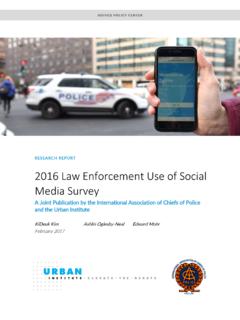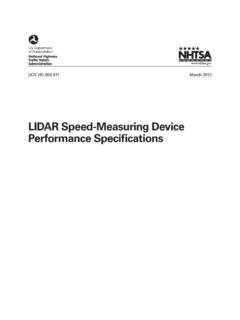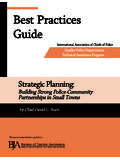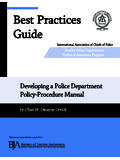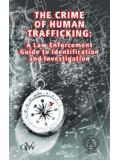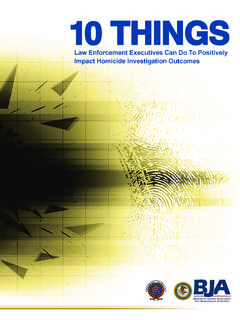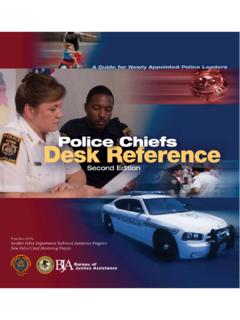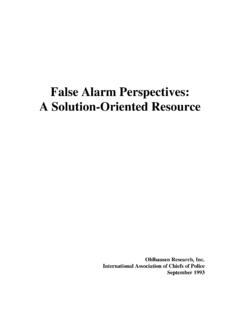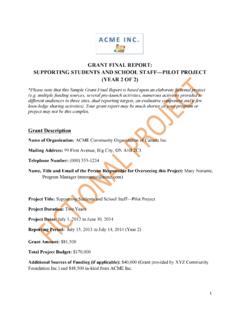Transcription of Reducing Officer Injuries FINAL REPORT - IACP …
1 The international AssociationA combined effort ofandThe IACP Center For Officer Safety & WellnessThe Bureau Of Justice Assistanceof Chiefs of PoliceA Summary of Data Findings and Recommendations from a Multi-Agency Injury Tracking StudyBureau of Justice Department of Justice FINAL REPORTR educing Officer InjuriesOVERVIEW OF CURRENT PROGRAMMINGThe international association of Chiefs of police (IACP)The IACP is the world s largest association of law enforcement executives. With more than 21,000 members in more than 100 countries, the IACP serves as the professional voice of law enforcement. Building on past success, the IACP addresses cutting edge issues confronting law enforcement through advocacy, programs, and research as well as training and other professional services.
2 IACP is a comprehensive professional organization that supports the law enforcement leaders of today and develops the leaders of safety and wellness has always been the top priority of the IACP, and its organizational belief is that no injury to or death of a law enforcement professional is acceptable. The IACP Center for Officer Safety and Wellness takes a holistic approach to Officer wellness by addressing the challenges in policing at all stages of an Officer s lifecycle, including recruitment, early career, advanced career, and retirement. More information on the Center can be found of Justice Assistance (BJA)BJA s mission is to provide leadership and services in criminal justice policy development and grant administration to support local, state, and tribal justice strategies to achieve safer communities.
3 BJA s comprehensive Officer safety portfolio provides law enforcement access to the information and tools they need to increase their capacity for and knowledge of Officer safety. Through BJA s programs, state, local, and tribal law enforcement executives and their officers receive quality training, technical assistance, tools, and resources to help them prepare for and prevent violent attacks against their s Officer safety programs are designed to assist law enforcement leaders in:- Preventing violent encounters and training their officers to survive them when they do Sharing critical information to improve officers awareness of any situation they may encounter and the most appropriate responses to critical Identifying potential danger and shielding their officers from Reducing overall violence in their Supporting their officers, their families, and their agencies should a tragic event information on BJA s Officer safety initiatives can be found of Justice Department of JusticeThis project is supported by Grant No.
4 2009-DG-BX-0027 awarded by the Bureau of Justice Assistance. BJA is a component of the Office of Justice Programs, which also includes the Bureau of Justice Statistics, the National Institute of Justice, the Office of Juvenile Justice and Delinquency Prevention, the SMART Office, and the Office for Victims of Crime. Points of view or opinions in this document are those of the author and do not necessarily represent the official position or policies of the Department of combined effort ofandThe IACP Center For Officer Safety & WellnessThe Bureau Of Justice Assistance FINAL REPORTR educing Officer Injuries12 ACKNOWLEDGEMENTS The international association of Chiefs of police (IACP) wishes to thank the many individuals and agencies who contributed to the findings in this REPORT :First, we wish to thank the 18 law enforcement agencies that provided extensive reporting data on Officer Injuries during the study.
5 Without the commitment of their respective personnel and the data contributions, this important effort would not have been possible. A complete list of participating agencies can be found in Appendix , we recognize the contributions of George Mason University, specifically the work of Assistant Professor Brian Lawton of the Department of Criminology, Law and Society. Dr. Lawton provided the necessary analytical review of a wealth of data that can be found in this of those involved are especially grateful to Captain Adrienne Quigley of the Arlington County (VA) police Department for her contributions toward this initiative.
6 Captain Quigley was the driving force behind the conception and realization of this project. Her previous research regarding Officer safety and wellness provided invaluable insight into the project, and her efforts to work with the participating agencies were , we acknowledge the Bureau of Justice Assistance (BJA) for providing both the financial support and the subject matter expertise that made this study possible. In particular, Steven Edwards and Deborah Meader provided guidance and collaboration throughout the project. Both IACP and BJA are committed to promoting safety and wellness initiatives across the law enforcement community and recognize that studies of this nature advance this OF CONTENTSE xecutive Summary 5 Section 1: Purpose of the Study 6 Section 2: Overview of the Study 7 Section 3.
7 Body Armor Wear 10 Section 4: Training 10 Section 5: Situation Characteristics 11 Section 6: Officer Characteristics 13 Section 7: Conclusion 14 Appendix A: Literature Review 15 Appendix B: Participating Agencies 18 Appendix C.
8 Data Collection Tool 19 FINAL REPORTR educing Officer Injuries34 EXECUTIVE SUMMARYIn order to begin to better understand the scope and frequency of Injuries sustained by law enforcement officers, the international association of Chiefs of police (IACP), through a cooperative agreement with the Bureau of Justice Assistance, Office of Justice Programs, Department of Justice, conducted a multi-department assessment of line-of-duty Injuries . Eighteen different agencies participated in this study and tracked all reported Injuries over the course of 1 year.
9 All available information pertinent to each injury was documented and entered into a database using a standardized reporting instrument built for this study. The IACP collected all data and partnered with George Mason University to perform an analysis of the data and develop strategies and resources for injury prevention. During the year of data collection, a total of 1,295 Injuries were reported. Reported Injuries resulted in 5,938 days missed, with an average of days missed per incident and an average rehabilitation period of days. Based on a 10-hour work day, this total represents 59,380 hours of work time lost. Using a national average annual entry-level salary of $40,000, the approximate total cost for hours lost from Injuries in this study was $1,211,352.
10 Factoring in the added costs of overtime to cover assignments for injured officers, an estimated $1,817,028 was also incurred by the participating agencies. When these two figures are combined, excluding the extra costs of medical care, the estimated total added costs exceed $3,000, addition to hours lost and resulting monetary cost, injury data collection focused on an array of other information, including specific injury type, characteristics of the injured Officer , involvement of a suspect in the injury incident, training received, Officer fitness attributes, and body weight. Additional information on vehicular crashes and the use of body armor was also obtained during the data collection to further inform the research effort.
